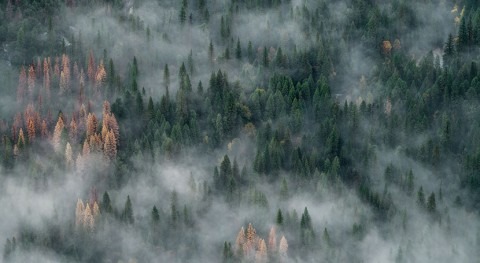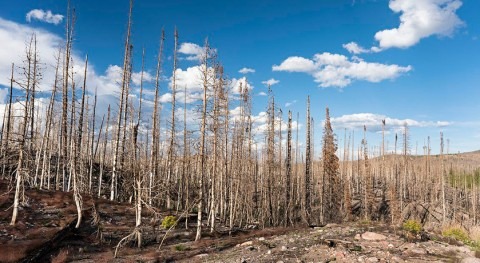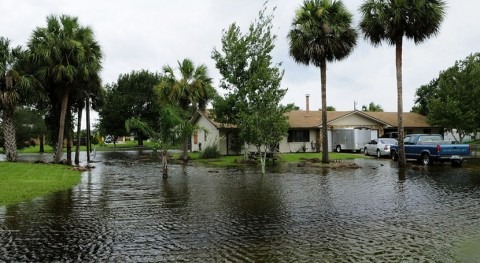Mangroves are tropical, salt-tolerant trees that grow in the intertidal zone of coastal waters. They don’t tolerate cold weather, particularly extreme freezes, during which they die and get replaced by coastal salt marshes.
In the 1980s, a series of freezes caused the most recent major die-off of Floridian mangroves (and citrus crops, which also fare poorly in cold weather). Since then, previous research showed, mangroves have flourished and expanded further from the tropics. As global temperatures continue rising, noting where mangroves and similar trees and vegetation flourish can serve as a marker to monitor the effects of climate change.
A new study led by UCLA’s Kyle Cavanaugh of how Florida’s mangroves and salt marshes are affected by changes in climate, both man-made and natural, illustrates the complex interplay between our changing climate and living natural systems.
The paper, which was published in PNAS, found that decades-long, natural climate cycles have determined the northern extent of Florida mangroves for at least the past 250 years. Freeze events that took place approximately every 10 to 30 years caused die-offs, during which mangroves were replaced by salt marshes until warmer trends spurred regrowth.
“We didn’t find evidence that climate change has altered this system to date,” said Cavanaugh, who is an assistant professor of geography and member of the UCLA Institute of the Environment and Sustainability. “But then we used climate model projections to look to the year 2100, and those suggest future warming will increase mangrove suitability.”
The research team had to look beyond satellite imagery to make these discoveries. To understand future warming projections, they relied on scientific climate models. To understand past natural cycles, they delved into a broad range of historical records: aerial images dating back to the 1940s, climate data dating back to the 1800s, citrus records and journals of early explorers, including naturalist John Muir.
In short, the paper found that while Florida’s mangroves have been on a northward march since the cold snaps of the 1980s, warming trends from climate change have not yet begun to play a significant role in the cyclical growth and retreat of mangroves. But the researchers project that to change.
In fact, it may already be changing, said Cavanaugh, who is an expert in coastal environments. Last winter’s polar vortex is similar to previous freezing events during the past 250 years. But while the latest vortex brought icy temperatures to much of North America, in Florida it didn’t quite get cold enough to kill off mangroves at large-scale.
“The probability of these freeze events will go down,” Cavanaugh said. “There’s evidence this latest expansion of mangroves will be prolonged.”
The paper also shed light on the complexity of climate change outcomes.

Photos from 1969, left, and 2018, of the area around the Fort Matanzas in Florida, show different density of mangrove trees.
Ecologically speaking, mangroves and salt marshes are both important natural environments. Mangroves provide habitat for manatees, tree crabs, oysters, and fish such as snook and snapper. Salt marshes host migratory shorebirds, bats, burrowing crabs and different species of fish. They both provide services to people, too, as sources of seafood and natural areas for recreation.
Still, it’s hard to ignore some of the extra protections against climate change that mangroves provide. They are highly effective at removing carbon from the atmosphere. And as they store carbon and other organic material underground, they slowly build elevation. In coastal Louisiana, where the amount of land being lost to erosion and subsidence is a major concern, “there are small-scale projects where they’re dropping propagules (seeds) out of planes to promote mangrove expansion,” Cavanaugh said. Mangroves also serve as a buffer against storm surge from hurricanes and other tropical storms, which are projected to increase and intensify under climate change.
News headlines tend to focus on the negative outcomes of the climate crisis, but the reality is more nuanced, and that’s what UCLA scientists like Cavanaugh are trying to understand.
“There are definitely going to be winners and losers. In a lot of cases it’s going to be positive for some things and negative for others,” Cavanaugh said. “Things are changing and it’s not always for the better or for the worse.”
That’s not to say that there’s no reason for concern. Climate change is an existential threat, many climate scientists believe. And the more rapidly our climate changes due to carbon emissions, the more likely we will see a greater proportion of negative impacts.
“It takes some time to adapt, whether you’re a human, a crab or a fish,” Cavanaugh said. “It’s hard to know where those tipping points are. We don’t know when these thresholds will be crossed and whether we can slow things down and give us sufficient time to adapt.”
The team of researchers who worked on this project included experts from Roosevelt, Columbia and Villanova universities, along with the Smithsonian institution.
Coauthor Ilka Feller of the Smithsonian Environmental Research Center, said this latest research is part of a long-term effort to understand how and why mangroves are expanding under climate change.
“Weather experts are doing a great job of figuring out these big, multi-decadal patterns — knowing that there are oscillations — and fitting that into the way people think climate change works,” Feller said. “People think it’s going to get hot and it’s going to stay hot. But variability is part and parcel of it. If you don’t understand the variability, you can’t understand the bigger picture.”
Florida is only one case in many. UCLA’s Cavanaugh is now researching how climate change will affect mangroves along the west coast of North America, where their northernmost growth has historically been limited to Baja California.












